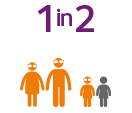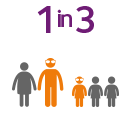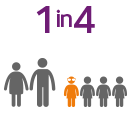
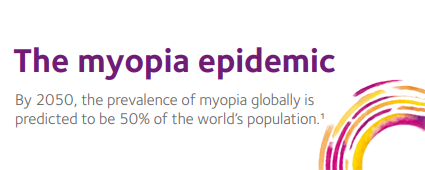
The last few decades have seen a steady rise in the prevalence of myopia across the globe.1 A growing body of evidence suggests that behavioural and lifestyle influences (education and environment) along with genetics, are contributing to the myopia 'epidemic'.
Genetics
Myopia in children increases when parents are myopic.2
The risk is nearly:
-

When both parents are myopic.
-

When one parent is myopic.
-

When neither parent is myopic.
Lifestyle
Modern lifestyles may influence the development of myopia.
Factors that could affect children’s vision:
-

Low levels of outdoor activity.3 4
-

Prolonged near tasks such as reading and gaming on portable devices.3 5
-

Poor lighting levels.3 5
Global prevalence of myopia
Children are becoming myopic at a younger age.6
This results in faster progression and ultimately, a higher level of myopia. Subsequently, children would become increasingly dependent on glasses and/or contact lenses with the associated lifestyle challenges they would experience.
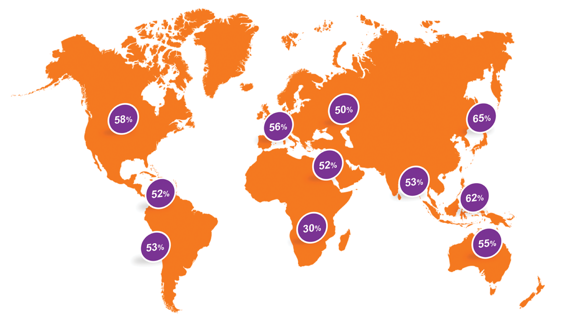
Why does myopia matter?
Myopia's link to retinal detachment and myopic macular degeneration is well established.
With increasing axial elongation comes the stretching and thinning of the retina, making it vulnerable to future eye health risks. For example, a -3.00D myope will require longer-term eye health management that includes monitoring for a three-fold risk of posterior subcapsular cataract and a ten-fold increase in the risk of retinal detachment and myopic macular degeneration compared to an emmetrope.7
Odds ratios for myopia-associated pathology
| Posterior subcapsular cataract | Glaucoma | Retinal detachment | Myopic macular degeneration | |
|---|---|---|---|---|
| -1.00 to -3.00 | 2.1 | 2.3 | 3.1 | 2.2 |
| -3.00 to -6.00 | 3.1 | 3.3 | 9.0 | 9.7 |
| Over -6.00 | 5.5 | 3.3 | 21.5 | 40.6 |
| Posterior subcapsular cataract | |
|---|---|
| -1.00 to -3.00 | 2.1 |
| -3.00 to -6.00 | 3.1 |
| Over -6.00 | 5.5 |
| Glaucoma | |
|---|---|
| -1.00 to -3.00 | 2.3 |
| -3.00 to -6.00 | 3.3 |
| Over -6.00 | 3.3 |
| Retinal detachment | |
|---|---|
| -1.00 to -3.00 | 3.1 |
| -3.00 to -6.00 | 9.0 |
| Over -6.00 | 21.5 |
| Myopic macular degeneration | |
|---|---|
| -1.00 to -3.00 | 2.2 |
| -3.00 to -6.00 | 9.7 |
| Over -6.00 | 40.6 |
The higher the level of myopia, the higher the risk
Odds ratios are a standard epidemiological approach to describe the increase in risk of a disease compared with a comparator group. In the table shown, the comparison is between people with different ranges of myopia vs. people who are emmetropic.

Higher myopes clearly have a greater risk of myopia-associated pathology, but it is important to understand that even low levels of myopia carry additional lifelong risks.

Starting myopia management early is important to help keep myopia levels (and importantly, axial length) at a level that helps to reduce risks.
-
Holden BA, Fricke TR, Wilson DA et al. Global Prevalence of Myopia and High Myopia and Temporal Trends from 2000 through 2050. Ophthalmology. 2016; 123:1036-42
-
Morgan P. Is Myopia Control the Next Contact Lens Revolution? OPTICIAN 2016
-
Gifford P, Gifford KL. The Future of Myopia Control Contact Lenses. Optom Vis Sci.; 93:336-43.
-
Rose KA, Morgan IG, Ip J, et al. Outdoor Activity Reduces the Prevalence of Myopia in Children. Ophthalmology 2008; 115:1279-1285.
-
Wolffsohn JS, Calossi A, Cho P, et al. Global Trends in Myopia Management Attitudes and Strategies in ClinicalPractice. Cont Lens Anterior Eye. 2016; 39:106-16.
-
McCullough SJ, O’Donoghue L, Saunders KJ (2016) Six Year Refractive Change among White Children and Young Adults: Evidence for Significant Increase in Myopia among White UK Children. PLoS ONE 11(1): e0146332. https://doi.org/10.1371/journal.pone.0146332
-
Flitcroft DI. The complex interactions of retinal, optical and environmental factors in myopia aetiology. Prog Retin Eye Res. 2012;31(6):622-660





